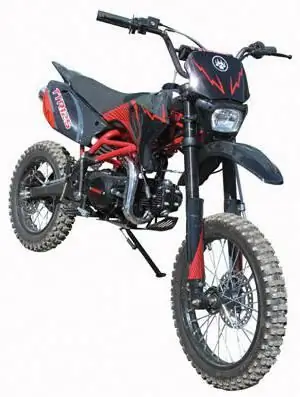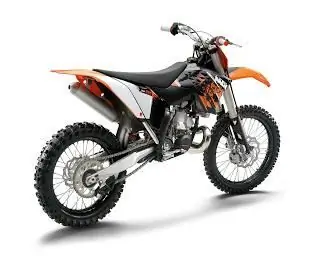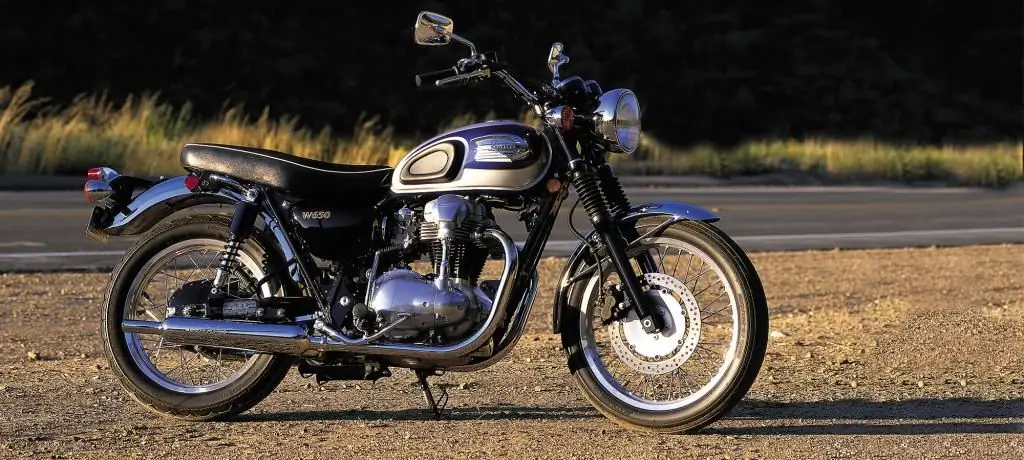2025 Author: Erin Ralphs | [email protected]. Last modified: 2025-01-22 21:14:09
The history of the retromotorcycle "Kawasaki W650" began in 1999 and ended only in 2008 with the final removal of the model from production. In the 60s of the last century, a similar motorcycle model was produced with a similar name and design, but these versions have nothing in common with each other.
Kawasaki W650 was created for the domestic market of Japan and Europe, but during the first four years of mass production it was supplied to North America, where it was discontinued in 2004 due to low sales. For the Japanese market, a model with a smaller engine capacity was produced - Kawasaki W400.
Motorcycle "Kawasaki W650" was equipped with a two-cylinder in-line engine with a capacity of 50 horsepower and a volume of 676 cubic centimeters with an air-cooled system. Against the background of similar models of motor vehicles, the W650 stood out for the presence of a kick starter and an electric starter, chrome parts and front hydraulic disc brakes (drum mechanisms were installed at the rear.
The Kawasaki W650 was finallyout of production in 2008. The motorcycle's successor, the Kawasaki W800, was released by a Japanese company only in 2010 and received an injection engine, but retained the classic design inherent in British motorcycles of the 1960s.

Engine
The engine installed on the Kawasaki W650 practically did not differ in characteristics from the prototype: a two-cylinder in-line unit with an air cooling system and a camshaft drive passing through a rod and a helical bevel gear. The engineers decided to keep the mechanical starter, despite the fact that the design implied an electric one. The power system was equipped with the usual carburetors, equipped, however, with a large number of electrical systems in order to comply with Euro-3 standards. The Kawasaki W650 engine was not very powerful, but could please with high traction at medium and low speeds.
Russian motorists in their reviews of the Kawasaki W650 called the main trouble associated with the engine the need to adjust the valves with a run of more than 30 thousand kilometers. The difficulty lies in the search for mechanics who can cope with the intricate design of the Japanese motorcycle engine. In other aspects, the power unit is reliable and unpretentious and can easily cover more than 100 thousand kilometers before its natural death.
Transmission
Rough operation of the gearbox, coupled with a quick search for neutral - a proprietary "trick" of all products of the Japanese company. Couldn't get away from this and KawasakiW650 ": the technical characteristics and engine power do not allow the transmission to be properly loaded, as a result of which its working life is similar to the life of the motor itself. Unfortunately, it is impossible to say the same about the clutch: at best, it will serve 40-50 thousand kilometers, after which will require replacement.

Frame construction and body kit
Like any other classic motorcycle, the Kawasaki W650 is completely devoid of any body kit, which significantly reduces the owner's recovery costs in the event of a fall or accident. However, there are some nuances here: the frame of the motorcycle is completely authentic, which affects the handling of the motorcycle and makes it practically unsuitable for recovery in more or less serious accidents due to the complete loss of body geometry. Actually, when buying, you should first of all pay attention to the frame and inspect it live, and not just from the photo of the Kawasaki W650.
Brake system
Rear drum-type brakes have one indisputable advantage - almost immortal overlays, but they do not cope very well with their immediate task. Catching the moment of full locking of the rear wheel is quite difficult, it takes a lot of effort to apply a lot of effort to the rear brake lever.
The front disc brakes are very different from the classics and have excellent information content, effectively slowing down the bike. The working life of the front brake pads is very decent - at least 15 thousand kilometers.

Pendant
The front-mounted telescopic fork has a feature that is useful in our conditions: its seals are covered with protective corrugations, which increases their working life and prevents dirt from entering. Of course, there are no suspension adjustments - they, however, are not required: the engineers of the Japanese concern managed to reach a compromise between comfort and roll - the suspension works almost perfectly. The spring preload of the rear shock absorbers can be changed by the owners. The springs themselves have a long service life.
Comfort level
Up to 110-120 km / h, the Kawasaki W650 motorcycle can be called ideal in terms of comfort and convenience. However, when overcoming this speed threshold, vibrations appear standard for a classic engine and the behavior of the suspension and frame deteriorates significantly.
Specifications
- The length of the motorcycle is 2190 millimeters.
- Width - 905 millimeters.
- Height - 1140 millimeters.
- Engine - in-line, four-stroke, two-cylinder, 50 horsepower.
- Five-speed transmission.
- Maximum speed is 166 km/h.
- The volume of the fuel tank is 15 liters.
- Dynamics of acceleration - 5.4 seconds.
- Curb weight - 212 kilograms.

Model history
Serial production of Kawasaki W650 was carried out from 1999 to 2008. The model was a remake of the W1 motorcycle650 equipped with a 1967 engine. The prototype for the W1 650 model was the licensed copies of the BSA A7 - Meguro K1 / K2 motorcycles, produced by the first Japanese motorcycle manufacturer Meguro, which was absorbed by Kawasaki in the 60s of the last century. Meguro was licensed to assemble the 500cc BSA A7 and its modified versions.
Kawasaki engineers redesigned the 650 Mizuro X, or A10, during the development of the new model, by modifying the engine, making the model more comfortable to ride and more dynamic. Over a ten-year period from 1965 to 1975, Kawasaki released three versions of the 650 cc model at once: W1, W2 and W3, gradually improving their performance and eliminating emerging problems.
In order to replace the Zephyr line of motorcycles, Kawasaki decided in 1999 to re-release its own models with the W index, as a result, the production of the W650 began, the successor of which was subsequently the W800. Engineers in the development of the Kawasaki W650 relied on all the experience of creating the classic W series, the British motorcycle Triumph Bonneville and other analogues. The new model was equipped with modern electronic equipment and an anti-vibration mechanism.
Simultaneously with the W650, the W400 model was produced: their production lasted until 2008, when new environmental standards were introduced and they ceased to comply with them. The company has decided to launch an updated version of the model with an 865cc engine, DOHC valve actuation and fuel injection.

Fuel consumption
The Kawasaki W650 consumes an average of 6 liters of fuel per 100 kilometers. Consumption may vary depending on driving style and road conditions.
Owner Reviews
Motor enthusiasts are very flattering in the first place about the classic retro design of the Kawasaki W650, noting that this appearance attracts the attention of not only other motorcyclists on more modern bike models, but also motorists. Despite the obvious agility and dynamism, the motorcycle is difficult to categorize as racing or sports - it was created for style, but not for setting speed records. There is a possibility of increasing the power, however, motorists in the reviews say that there is no need for such tuning: the W650 is made in the spirit of the good old British classics, and no one wants to spoil it with excessive modifications.
Motorcycle cost
In the secondary market, "Kawasaki W650" in good technical condition and without a run across the Russian Federation can be purchased for 240-300 thousand rubles. Models with mileage in Russia will cost at least 190 thousand rubles.
Recommended:
TTR-125 off-road motorcycle: specifications, photos and reviews

"Irbis TTR 125" refers to off-road motocross motorcycles. This excellent machine is perfect for beginners who dream of motocross and crave to experience a lot of adrenaline. From the article you will learn what off-road motorcycles are in general and Irbis crossovers in particular, about the advantages and disadvantages of the TTR 125 model and what should be done when you have just purchased the device
Cross motorcycle: specifications, photos and reviews of manufacturers

Cross bikes: overview, specifications, features, operation, photos, maintenance. Cross-country motorcycle: description of the best models, reviews of manufacturers. Motocross motorcycles 250 and 125 cubes: comparison, features
BMW K1300S motorcycle: specifications, photos and reviews

The BMW K1300S is strong, invulnerable and agile. This is an ideal technique for those who lead an active lifestyle and never sit in one place
Yamaha Virago 400 motorcycle: specifications, photos and reviews

Yamaha Virago 400 motorcycle: description, features, operation. Motorcycle "Yamaha": price, reviews, specifications, photos
Motorcycle "Kawasaki Ninja 600" (Kawasaki Ninja): specifications, description, reviews

The Japanese motorcycle "Kawasaki Ninja 600" was produced at the factories of Kawasaki Motorcycles from 1985 to 1995 and was intended for road racing

